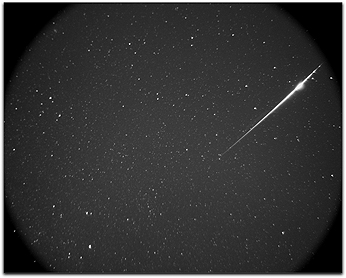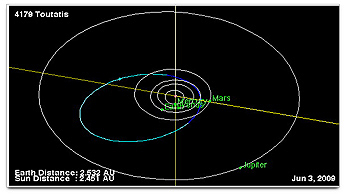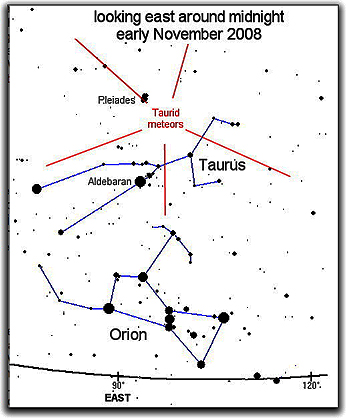 November is a most exciting month for activity in space — Midnight Fireballs are visible late at night as Earth is passing through a swarm of gritty debris from comet 2P/Encke causing a slow flurry of Taurid fireballs.
November is a most exciting month for activity in space — Midnight Fireballs are visible late at night as Earth is passing through a swarm of gritty debris from comet 2P/Encke causing a slow flurry of Taurid fireballs. You may need to exercise some patience to observe the sights, but it is certainly worth the wait as you can see by the photo on the right taken by
Frank R Uroda, NW of Port Huron, Michigan, USA Nov. 5, 2008.
The
orbital diagram at the left is interactive and can be accessed
at this site.

Also on the program are
Potentially Hazardous Asteroids (PHAs) which are defined based on parameters that measure the asteroid's potential to make
threatening close approaches to the Earth. Specifically, all asteroids with an
Earth Minimum Orbit Intersection Distance (MOID) of 0.05 AU or less and an absolute magnitude (H) of 22.0 or less are considered PHAs. In other words, asteroids that can't get any closer to the Earth (i.e. MOID) than 0.05 AU (roughly 7,480,000 km or
4,650,000 miles) or are smaller than about 150 m (
500 feet) in diameter (i.e. H = 22.0 with assumed albedo of 13%) are not considered PHAs. (Not dangerous when they're less than 500 feet in diameter? Pass the helmets, please!)
Orbit Viewer applet originally written and kindly provided by Osamu Ajiki (AstroArts), and further modified by Ron Baalke (JPL).

There are
currently 997 known PHAs, and while there is the potential to make close Earth approaches, it
doesn't mean a PHA will impact the Earth. It
only means there is a possibility for such a threat. By monitoring these PHAs and updating their orbits as new observations become available predictions regarding the close-approach statistics are more accurate, and thus their Earth-impact threat. We always appreciate the variety of info that is available
at this site.
Topical Tags :
Regional Tags :